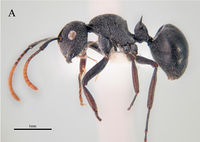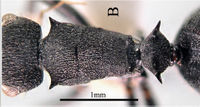Polyrhachis brevipilosa
| Polyrhachis brevipilosa | |
|---|---|

| |
| Scientific classification | |
| Kingdom: | Animalia |
| Phylum: | Arthropoda |
| Class: | Insecta |
| Order: | Hymenoptera |
| Family: | Formicidae |
| Subfamily: | Formicinae |
| Tribe: | Camponotini |
| Genus: | Polyrhachis |
| Subgenus: | Myrma |
| Species group: | revoili |
| Species: | P. brevipilosa |
| Binomial name | |
| Polyrhachis brevipilosa Rigato, 2016 | |
Nothing is known about the biology of Polyrhachis brevipilosa.
Identification
Rigato (2016) - A small species in the A member of the revoili-group with lobed clypeus, weakly marginate pronotum, minute propodeal teeth, rough reticulate-punctate sculpture, and relatively abundant and short standing hairs on body and appendages.
Polyrhachis brevipilosa is the smallest species of the revoili-group. Only Polyrhachis luteipes and Polyrhachis regesa have a comparable size. Polyrhachis luteipes differs especially for its much weaker sculpturation, paler appendages and immarginate pronotum. Polyrhachis regesa is very similar to brevipilosa, but they can be distinguished as reported in the key. I examined the holotype of P. regesa and realized that the metanotal suture is not completely wanting as stated by Bolton and a faint trace remains visible under certain lights. Also, the propodeal “tubercles” (in Bolton’s own words) of regesa look like weak ridges because they are relatively wide and much closer to one another than in brevipilosa, where they are short and tooth-like.
Keys including this Species
Distribution
Latitudinal Distribution Pattern
Latitudinal Range: -2.30921° to -2.315°.
| North Temperate |
North Subtropical |
Tropical | South Subtropical |
South Temperate |
- Source: AntMaps
Distribution based on Regional Taxon Lists
Afrotropical Region: Congo, Gabon (type locality).
Distribution based on AntMaps
Distribution based on AntWeb specimens
Check data from AntWeb
Countries Occupied
| Number of countries occupied by this species based on AntWiki Regional Taxon Lists. In general, fewer countries occupied indicates a narrower range, while more countries indicates a more widespread species. |

|
Estimated Abundance
| Relative abundance based on number of AntMaps records per species (this species within the purple bar). Fewer records (to the left) indicates a less abundant/encountered species while more records (to the right) indicates more abundant/encountered species. |

|
Biology
Castes
Nomenclature
The following information is derived from Barry Bolton's Online Catalogue of the Ants of the World.
- brevipilosa. Polyrhachis brevipilosa Rigato, 2016: 11, figs. 1a-c (w.) GABON.
Unless otherwise noted the text for the remainder of this section is reported from the publication that includes the original description.
Description
Worker
Rigato (2016) - Holotype. HL 1.07, HW 0.89, CI 83, SL 1.21, SI 136, FW 0.33, FI 37, PW 0.79, WL 1.27, HTL 1.21.
Clypeus medially fairly distinctly carinate and with its anterior margin bearing a small protruding rectangular lobe, whose lateral corners are distinctly right-angled. Head in full face view subtrapezoidal, wider behind than in front, posterior margin wide and weakly convex with widely rounded posterior corners. Eyes relatively large and protruding. Mesosoma stout, evenly convex in profile. Pronotum laterally marginate, the margination interrupted a little in front of the promesonotal suture; mesonotum and propodeum immarginate. Pronotal teeth anteriorly diverging, relatively short and sharp. Promesonotal suture distinct, metanotal suture weaker and hardly interrupting the sculpturation. Propodeal teeth reduced to minute tubercles. Propodeal dorsum and declivity confluent in a blunt curvature. Petiole with four thin spines, the dorsal pair directed upward and slightly backward and about 1.5 times as long as the lateral pair. Petiolar dorsum in frontal (or posterior) view obtusely angled in the middle. First gastral tergite anteriorly concave.
Mandibles superficially striolate/shagreened and with sparse piligerous pits. Head, mesosoma, petiole and appendages reticulate-punctate and with a rough appearance, dull. Dorsum of head, pronotum and mesonotum also with a superimposed, relatively dense, coarse longitudinal, sometimes inconspicuous, rugulation. Gaster finely reticulate-punctate and fairly shining.
Pubescence fine, whitish, short and moderately dense on most of the body and appendages, but sometimes poorly visible and never hiding the sculpturation. Standing hairs relatively short and moderately abundant on body and appendages, absent from the petiole. Longest hairs occur on head and leading edge of scapes. Few hairs on scapes longer than scape width at midlength; standing hairs on tibiae distinctly shorter than maximum tibial width.
Body black, legs mostly concolorous with the body, tibiae dark brown; antennal funiculi mostly testaceous, mandibular apex ferrugineous.
Paratypes. (n=2). HL 1.10–1.34, HW 0.91–1.07, CI 80–83, SL 1.27–1.48, SI 138–140, FW 0.34–0.42, FI 37–39, PW 0.82–1.02, WL 1.39–1.65, HTL 1.24–1.42. The smaller specimen does not significantly differ from the holotype. Yet an unexpectedly large specimen has a seemingly stouter mesosoma and pronotal teeth, and stronger petiolar spines (dorsal and lateral pairs more similar in size also). In my opinion, these differences are slight and possibly due to allometry.
Type Material
Rigato (2016) - Holotype worker. GABON: La Makandé, Forêt des Abeilles, I–II.1999, A. Dejean (The Natural History Museum). Paratypes. REPUBLIC of the CONGO: Niari Region, 2.30921 S 12.82224 E, 754 m, 4.vii.2013, primary forest, canopy fogging (L. Niemand) (1 w, AFRC: LN-RC1-044, CASENT0250041); Niari Region, 2.31500 S 12.82488 E, 710 m, 5.vii.2013, primary forest, canopy fogging (L. Niemand) (1 w, Afribugs Collection: LN-RC1-041, CASENT0250033).
References
References based on Global Ant Biodiversity Informatics
- Rigato F. 2016. The ant genus Polyrhachis F. Smith in sub-Saharan Africa, with descriptions of ten new species. (Hymenoptera: Formicidae). Zootaxa 4088: 1-50.

